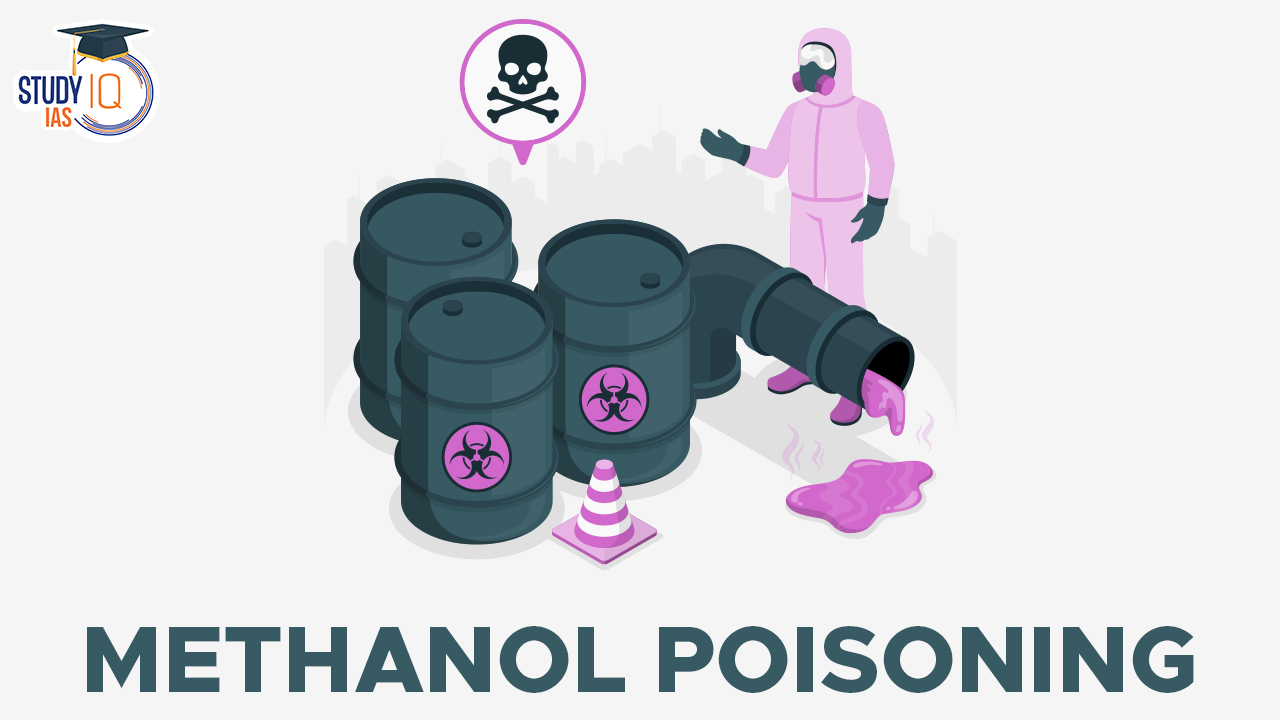Table of Contents
Context: As many as 22 people had died after consuming spurious liquor in Tamil Nadu.
What is Alcohol?
Alcohol, in the context of beverages, refers to a group of organic compounds known as alcohols that contain a hydroxyl (-OH) functional group attached to a carbon atom. Ethanol (ethyl alcohol) is the most common type of alcohol used for recreational and social purposes.
- Liquor is differentiated by its alcohol content – from the 5% or so of beer to the 12% or so of wine to the 40% or so of distilled spirits (all by volume).
- Ethanol is a psychoactive drug that, in low doses, reduces the level of neurotransmission in the body, leading to its typical intoxicating effects.
- Ethanol (C 2H 5OH) is one carbon atom bonded to three hydrogen atoms and one more carbon atom; the second carbon atom is also bonded to two hydrogen atoms and the hydroxyl group, a.k.a. the ion OH –.

Working of Alcohol in Human Body
- Inside the body, it is metabolised in the liver and the stomach by alcohol dehydrogenase (ADH) enzymes to acetaldehyde.
- Aldehyde dehydrogenase (ALDH) enzymes transform the acetaldehyde into acetate.
- Adverse effects of alcohol consumption are due to acetaldehyde.
- According to World Health Organization no level of liquor consumption is safe for our health.
- Long-term use leads to dependence, heightens the risk of some cancers and heart disease, and may eventually cause death.
About Spurious Liquor & Methanol Poisoning
- In every death due to consumption of spurious liquor in India, methanol has been the killer.
- Spurious Liquor is characterised by the liquid mixture containing methanol along with ethanol.
- Methanol is added in the liquor to strengthen the intoxicating effects and/or to increase its bulk volume.
- Methanol Poisoning: Once ingested, methanol is metabolised in the liver by ADH enzymes to form formaldehyde.
- ALDH enzymes convert formaldehyde to formic acid. The accumulation of formic acid leads to a condition called metabolic acidosis.
- Acidosis can lead to acidemia, a condition wherein the blood’s pH drops below its normal value of 7.35, becoming increasingly acidic.
- Formic acid also interferes with an enzyme called cytochrome oxidase, which in turn disrupts cells’ ability to use oxygen and leads to the formation of lactic acid, contributing to acidosis. This ultimately leads to death.
- Formic acid would have begun accumulating in dangerous amounts around 18-24 hours after ingestion, affecting the optic nerve, kidneys, the heart, and the brain.
About Methanol
- Methanol is commonly produced by combining carbon monoxide and hydrogen in the presence of copper and zinc oxides as catalysts at 50-100 atm of pressure and 250°C.
- Methanol has several industrial applications including the production of acetic acid, formaldehyde, and aromatic hydrocarbons.
- It is also used as a solvent and as antifreeze.
Regulation of Methanol
- Schedule I of the Manufacture, Storage and Import of Hazardous Chemical Rules 1989 includes methanol.
- The Food Safety and Standards (Alcoholic Beverages) Regulations 2018 stipulate the maximum permissible quantity of methanol in different liquors.
- Indian Standard IS 517, specifies how to determine the quality of methanol.
- Tamil Nadu Denatured Spirit, Methyl Alcohol, and Varnish (French Polish) Rules 1959, specifies what labelling and packaging requirements should be present for methanol.
Treatment of Methanol-Poisoning
- Pharmaceutical-grade ethanol should be administered by healthcare workers because ethanol checks methanol from being metabolised to formaldehyde. Thus, preventing it from becoming poisonous.
- Fomepizole should be administered. It slows the action of the ADH enzymes, causing the body to produce formaldehyde at a rate that the body can quickly excrete, preventing the deadlier effects.
- Healthcare workers may recommend dialysis to eliminate methanol and formic acid salts from the blood.
- They may also administer folinic acid, which encourages the formic acid to break up into carbon dioxide and water.


 Daily Quiz 03 July 2025
Daily Quiz 03 July 2025
 Dalai Lama Confirms He will have a Succe...
Dalai Lama Confirms He will have a Succe...
 List of Awards and Honours Received by N...
List of Awards and Honours Received by N...





















